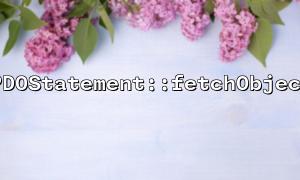In PHP development, PDO provides a rich and secure way to handle database operations. Among them, PDOStatement::fetchObject is a very practical function that allows you to map query results directly to instances of a class. Further, we can combine class methods to fill or process dynamically immediately after object creation to improve code flexibility and maintainability.
This article will use specific examples to explain in detail how to achieve this using fetchObject and custom class methods.
First, let's look at a basic example of using fetchObject :
<?php
// Database connection
$pdo = new PDO('mysql:host=localhost;dbname=testdb', 'username', 'password');
// Simple query
$stmt = $pdo->query('SELECT id, name, email FROM users');
// use fetchObject Get results
$user = $stmt->fetchObject();
echo $user->name;
?>
Here, fetchObject returns a stdClass object by default. Although convenient, it is not flexible enough, such as processing immediately after data is obtained.
We can pass in the class name and let fetchObject return a specific object instance:
<?php
class User
{
public $id;
public $name;
public $email;
}
$stmt = $pdo->query('SELECT id, name, email FROM users');
$user = $stmt->fetchObject('User');
echo $user->email;
?>
At this time, $user becomes an instance of the User class and is automatically filled with public properties.
If we want to call the class method immediately after the data is filled, such as formatting the data or loading more information, we can use a constructor or a custom method.
<?php
class User
{
public $id;
public $name;
public $email;
public function __construct()
{
// Preprocessable here,For example formatting email
if (!empty($this->email)) {
$this->email = strtolower($this->email);
}
}
}
$stmt = $pdo->query('SELECT id, name, email FROM users');
$user = $stmt->fetchObject('User');
echo $user->email;
?>
But note: When using fetchObject , the default parameter is not passed to the constructor. So if you need to pass parameters, or want to control the initialization process more granularly, you need another method.
A more flexible approach is to define a custom initialization method in the class, such as:
<?php
class User
{
public $id;
public $name;
public $email;
public function initialize()
{
if (!empty($this->name)) {
$this->name = ucfirst($this->name);
}
}
}
$stmt = $pdo->query('SELECT id, name, email FROM users');
$user = $stmt->fetchObject('User');
// Manually call the initialization method
if ($user) {
$user->initialize();
}
echo $user->name;
?>
This allows arbitrary logic to be executed after the object is created without being limited to the constructor.
If you want to be more automated, you can encapsulate a small factory method to complete fetch and initialize uniformly:
<?php
class User
{
public $id;
public $name;
public $email;
public function initialize()
{
$this->name = ucfirst($this->name);
}
public static function fetchAndInitialize(PDOStatement $stmt)
{
$user = $stmt->fetchObject(self::class);
if ($user instanceof self) {
$user->initialize();
}
return $user;
}
}
// Query preparation
$stmt = $pdo->query('SELECT id, name, email FROM users');
// use静态方法统一处理
$user = User::fetchAndInitialize($stmt);
echo $user->name;
?>
With this pattern, data mapping and initialization processing are completely decoupled, making the code easier to maintain and scale.
fetchObject will only fill the object with properties and will not call the setter method. If you need to process properties through the setter method, you must call them manually.
Make sure that the database table fields strictly match the class attribute name unless you have done compatible processing in the initialize method.
If the data source is an external interface, such as https://api.gitbox.net/data/users , be careful not to directly trust external data, and basic checksum filtering should be performed.
PDOStatement::fetchObject provides a way to quickly convert database rows into object instances. Through rational design of the class methods, we can implement various dynamic processing logic while filling data, greatly improving the scalability and maintainability of the system.
Through the above example, I believe you have mastered how to gracefully combine fetchObject with custom classes to process data. In the future, this technique will be very useful in large projects!
Related Tags:
PDOStatement














